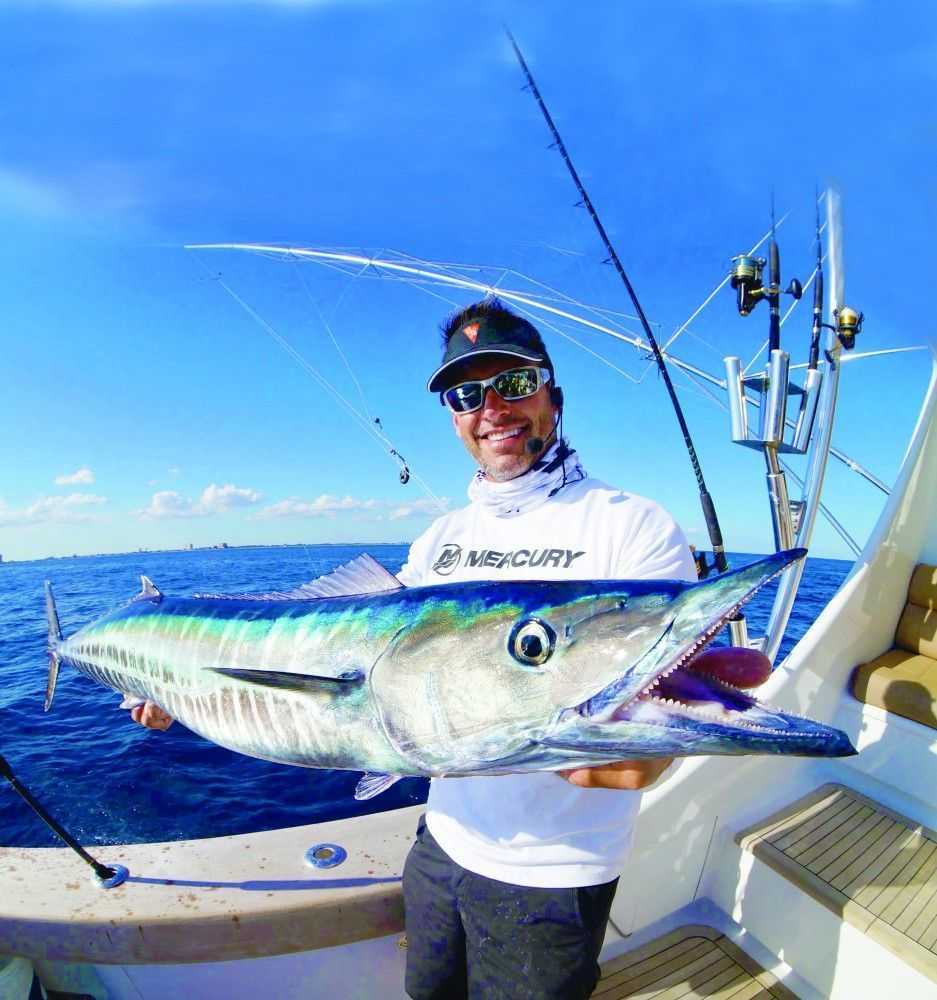Wahoo! Wherever They May Roam
By CAM Staff
Whether as an incidental catch, when one screams into a billfish spread, or when high-speed trolling to specifically target them, wahoo are a favorite fish for any angler who has ever been hooked up to one.
They are incredibly fast, sleek and powerful. The initial blistering 300-yard run is enough to hook anyone. With line pouring off the reel, instinct begs you to stanch the flow. But a wahoo will throw the hook in a heartbeat, and there can be no slack in the line. Just hold on. The fight is predictable. After that first long run, the fish will most likely turn back to the boat, shaking its head to throw the hook. Then it’s a sprint to pick up line. A little help from the helm might even be in order.
If you do manage to bring it into the boat, the beauty of the fish will amaze you. Perfectly camouflaged in blue water, a wahoo’s silvery belly gives way to a dark blue back with undulating cobalt blue bars falling vertically down its sides. If you can look past that weird toothy beak, it is a gorgeous fish. Photos never do it justice, as the color starts fading as soon as you take them from the water.
What doesn’t fade is the excitement this species brings to the supper table. They are mackerel, but they don’t taste like it. Unlike king mackerel, which look and swim a lot like wahoo, there are no heavy blood lines nor oiliness in a wahoo’s flesh. The meat is snow white, firm and has a mild taste sometimes compared to albacore.
It’s a tremendous sportfish that travels in loose schools and sometimes feeds in packs. Find one and you’ll likely find several hanging and feeding near blue water structure. They move and feed with the bait, migrating to stay in the water temps they prefer, 70 degrees and higher, but they’ll almost always be found near structure, whether it’s a ledge in the Atlantic or a Gulf oil rig. This might lead one to believe that wahoo might be easier to pattern than other pelagic species, but they are notoriously unpredictable. They are streaky feeders, and might not eat unless time of day, tides and moon phases align just right. For a long time, this unpredictable nature relegated wahoo to the realm of happy bycatch for anglers seeking other species. It is only recently, relative to the history of sportfishing, that people have developed tactics specifically for wahoo.
From the deep canyons off the northeast U.S. south to the east coast of Florida and throughout the Caribbean and Gulf of Mexico, they can be found in catchable numbers seasonally. There’s little scientific data, but anecdotal evidence suggests they move with the rest of the pelagics, north in winter and south in summer.
Off the Carolina coast, the activity is best in the warm waters of late summer through early fall, which is also when schools of small tuna show up to winter. Anglers can hope for double-digit wahoo encounters during the peak season, with fish sometimes weighing more than 60 pounds.
Late winter is the time to catch them off northeast Florida, when they will be feeding on the ledges with a bite that sometimes lasts all the way into April. Expect decent numbers of fish from 35 to 60 pounds, and every year a few fish show up heavier than 80 pounds. Down in South Florida, wahoo can be found on the edge of the Gulf Stream, with peak fishing occurring late spring through summer. During that same time period, anglers in the Keys will be targeting smaller wahoo, averaging 25 pounds, on floating debris.
But arguably the best wahoo fishing in this part of the world is the Bahamas. Here there is a shot at triple-digit fish, and good numbers of fish in the 40-pound range are the norm. Winter is best from the northern Bahamas around the Abacos and farther south, around the San Salvador humps.
In the Gulf, wahoo season is in winter, but winter brings with it foul weather. Early spring is a favorite time of many captains to chase wahoo because the fish are still around and you can actually get to them. They’ll be hunting in packs and following baitfish. There’s a good chance at some 30- to 50-pounders this time of year, and 80- or 90-pound fish are not unheard of in Gulf waters.
So maybe it’s time you too started viewing wahoo as more than an incedental catch. There’s somewhere nearby to go chase them pretty much year-round. And if you want to make a big trip of it, there’s always Hawaii or Fiji. We hear the wahoo fishing is pretty good in the Pacific, too.
